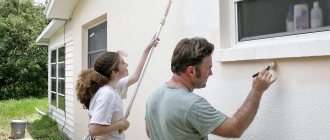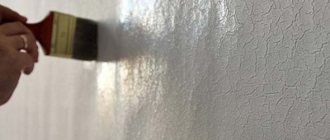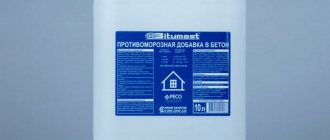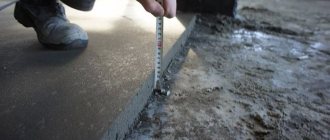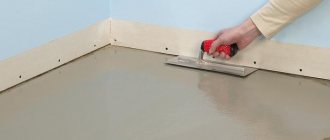What is a primer
Primer is a unique composition that improves the adhesion of finishing materials to each other. In addition, the mixture has an antifungal composition that prevents mold from forming.
On a primed surface, the consumption of paint, glue or finishing plaster is significantly reduced. But in order for the primer to acquire its properties, it is necessary to wait for it to dry completely.
Floor primer: choosing a suitable solution and features of its application
Concrete floors have high porosity and poor adhesion, which prevents the high-quality fixation of most finishing coatings. Paint, tiles and even self-leveling mixtures will cause you a lot of trouble if you do not apply preliminary priming. We will look at which primer is best for the floor and how to apply it in this article.
DIY concrete floor priming
What determines the drying time?
Drying time depends on several factors:
- Type of primer. The mixture differs in composition, and the drying time differs accordingly.
- Wall material. Since materials differ in their ability to absorb moisture, the time will vary from several hours to several days. Dries faster on porous, dry surfaces.
- Number of primer layers.
- Temperature and humidity in the room where the work is being done.
Features of installing a clean floor made of ceramic tiles over a semi-dry screed
The very name of this type of coating speaks about the technology of its construction. This design is completed much faster than any wet screed, since installation occurs using a special plastering station with a pump. This method of rough flooring has the following advantages and disadvantages:
- Undoubtedly, after smoothing the laid hard semi-dry mixture using a vibrating plate, its surface becomes smooth and is well suited for installing porcelain stoneware.
Rice. 7. Hard floor preparation using professional equipment
- Unlike classic wet screed, this type of subfloor has a high porosity, which indicates significant moisture absorption. This means that roll polyethylene waterproofing should be laid under the screed, sealing the joints in places where the material overlaps. In addition, after it has hardened, it would not be superfluous to treat the surface with a synthetic water-repellent compound.
- Just like with a wet screed, a semi-dry structure requires mesh reinforcement and cannot be too thin to avoid the formation of cracks.
Rice. 8. Installation of ceramic tiles on top of a dried semi-dry screed
Types of primer
The primer is sold in two types:
- In the form of a dry mixture that must be diluted with water;
- In liquid form, ready for use.
The composition can penetrate surfaces up to 1 cm deep. Based on the depth of penetration, they are divided into:
- Deep penetration. Apply to wooden and porous walls. Dry within 24 hours.
- Quick drying. Suitable for metal surfaces. Dries from one to four hours depending on the number of layers applied.
- Universal adhesive compositions. Can be applied to any type of surface. Dries from 4 to 10 hours. The time also depends on the number of layers applied.
- Concrete contact. Applied to concrete walls, most often used for exterior work. Dries in 12 to 24 hours.
- Drying oil. Used for woodworking. It dries in at least a day.
How long does it take to prime before painting?
They form a loose waterproofing layer on the treated surface, which effectively resists the penetration of moisture into the wall.
Deep penetration primers are used on porous and loose surfaces that need to be strengthened before subsequent decorative finishing. This primer reduces the drying time of the glue, due to the fact that when applying glue to the primer, the composition becomes more viscous. The wallpaper sticks quite firmly to the walls and ceiling. Primers with a mineral base are used as the initial material for leveling the surface. They contain cement. A special feature of this mixture is deep absorption, which allows it to tightly bind the surface. They are odorless, non-toxic, and perfectly fill the pores of loose substrates, giving them the desired density. Ideal for walls finished with chipboard or crumbling plaster. Complete drying time is about 5 hours. Primers for highly specialized applications are produced for treating metal and concrete surfaces.
Drying time on various surfaces
When working with different surfaces, it is worth considering the type of primer and its drying time. You can check whether the layer has dried with a special moisture meter.
If you don’t have such a device at hand, you should follow the instructions left by the manufacturer on the packaging.
Plaster
The plaster is based on a sand-cement mixture, therefore it is highly absorbent. The walls are covered with a thick layer of primer; there should be no dry spots left immediately after treatment. One layer dries completely in 4 hours.
If you plan to lay tiles in the future, you don’t have to wait for complete drying. In this case, the dust will settle and will not interfere with the work.
putty
Impregnation of putty walls with a primer is mandatory. Otherwise, the material will significantly increase the consumption of paint or glue during further work.
- The primer layer should be thin.
- Otherwise, cracks may form on the wall.
- The drying time for one layer in this case is 3-4 hours.
Drywall
The material absorbs moisture well, so one coat is sufficient. Dries in about 3 hours at a temperature of 20 degrees and normal humidity levels.
- If it is necessary to apply a second layer, the work should be done 4 times after applying the first.
- The lack of shine on the surface indicates that the primer has completely dried.
Tree
Wood must be primed to increase its service life. The primer has a bactericidal composition and does not allow the material to rot, and also prevents the appearance of bugs.
- Wooden walls absorb coating well.
- The composition is applied in at least two layers.
- Drying time is 12-20 hours at temperatures above 19 degrees.
Brick
For processing, universal primers or deep penetration compounds are most often used.
- Depending on the age of the brickwork, the coating occurs in several layers.
- One layer dries in 4-5 hours.
- If there is limescale on the wall, the polymerization period increases to 8-10 hours.
OSB boards
OSB boards are coated with a paraffin protective layer in production. It must be removed before applying the primer. Otherwise, the composition will not be absorbed, and the paraffin will fall off over time and the stove will become unusable.
- Most often, oil-based or synthetic-based primers are chosen for OSB processing.
- With them, the slab does not swell, and its service life increases. Drying time is 24 hours.
Features of the composition
The main advantage of the primer was its binding ability. Due to this parameter, the consumption of paints and varnishes, adhesive composition and other materials is greatly reduced. high-quality primer material has excellent antifungal and antibacterial qualities. Due to these characteristics, you can safely engage in wallpapering and not be afraid of the formation of mold and fungal colonies in the future.
Many people consider the use of such a product before painting or pasting walls to be pointless. Most often this will concern people or novice craftsmen who want to carry out home repairs with their own hands. Only after a while will they begin to understand how deeply everyone is mistaken. The fact is that preliminary priming of the walls will help you save a lot on other finishing materials. After applying the priming compound, you must wait a certain time before starting repair work. Manufacturers usually prescribe the waiting period on the packaging with the composition. But this criterion may change due to the type of base and other aspects. If the surface is porous or dry, then further work can begin after a short period of time.
Please note that before purchasing such a product, you should decide on what surfaces it will be used. You should not forget about the included instructions for the solution, and the higher the penetrating ability of the composition, the better it is.
How to speed up drying
In situations where finishing work needs to be done urgently and it is not possible to wait for the primer to dry completely, you can use various tricks. But each of the tricks has its negative sides.
Heat gun
The primer dries well if the room temperature is above 21 degrees and average air humidity. But it is not always possible to create such conditions. In this case, you can use a heat gun.
The device can be easily moved from room to room. Preference should be given to a gun with a power of up to 2 kW. But it can only be used if accelerated drying is allowed according to the instructions. Otherwise, cracks may form.
When working, it is worth considering the following nuances:
- The unit cannot be directed to individually selected areas. The air should spread over the entire surface of the walls.
- The gun should only be turned on at minimum or medium power.
- The temperature should not exceed 30 degrees.
- The device should be kept away from the wall.
- Periodic ventilation is required.
Special impurities
Construction stores sell special mixtures that reduce drying time. They mix into the primer before application. See the instructions on the package for proportions.
You can also immediately purchase soil with already added impurities. In this case, the drying time will also be indicated by the manufacturer.
When working with such compounds, be sure to follow safety precautions:
- Processing should be done only with a respirator and gloves.
- Since the mixtures are toxic and can lead to poisoning.
Open windows
Depending on the time of year and weather conditions, you can open the windows to dry the primer. Excessive moisture should not get on the treated walls. And the air temperature in the room should be kept at least 20°C.
Direct sunlight hitting a primed wall can cause the composition to dry out and cracks to appear. Therefore, it is better to keep windows open in warm, but not sunny weather.
It is recommended to periodically ventilate the room. Then the coating will set faster.
Base requirements
There are a number of requirements that apply to all types of bases for this floor covering. These include:
- Evenness. The maximum permissible difference in height is 2 mm per 2 linear meters of surface length.
- Purity. Fine sand and dirt particles remaining under the laminate create an unpleasant squeaking sound when moving on it.
- Uniform slope. This parameter should not exceed 4 mm per 2 m2 of room.
- Dryness. Any substrate must be allowed to dry thoroughly before applying primer. Otherwise, this may lead to swelling of the coating.

